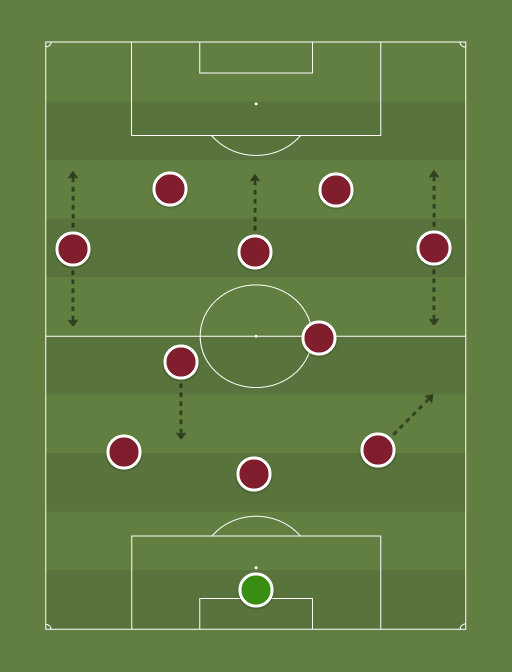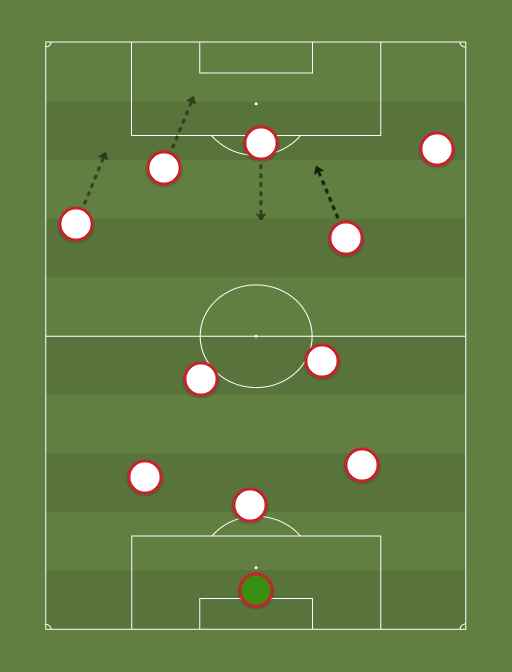Joga Bonito
The Art of Football
- Joined
- Jul 14, 2014
- Messages
- 8,270
Voters are asked to consider the XIs featured as remakes of classic teams, and to consider to what extent the manager has succeeded in re-creating both the individual roles and the overall functionality of the original. THIS IS NOT A FANTASY MATCH BETWEEN TWO SIDES, but rather a comparison of remakes.
Please feel free to tag the managers if you require more information about their set-ups/players etc.
No generation was as golden as Hungary's Golden Team that dominated international football in the early 1950s. The Magical Magyars were a step ahead of their peers: shaking off the shackles of the WM formation to unleash a 3-2-1-4 / 4-2-4 hybrid that bamboozled the world. At the heart of Gusztav Sebes' system was the deep-lying centre-forward, initially developed by MTK coach Martin Bukovi, whose positioning, ability to dictate play and overload in and beyond the hole was central to the Magyars' sustained success.
Style - Fluid, ball dominating and on the front foot
Defense - High line organised by a centre-half-cum-sweeper who builds play from deep. Combination of man and zonal marking as the situation dictates. Look to win the ball back early to carry on attacking.
Midfield - Classy and imposing: look to dominate and circulate the ball with superior technique. Uses Lahm as an overload down the right.
Attack - Fluid: intelligent through the middle and swashbuckling on the flanks
Player Roles
Claudio Bravo - good on the ball and shines with a high line. Grosics: "There was space behind our defence and I had to act as a kind of extra sweeper outside of my area".
Alessandro Nesta - immaculate all-round defender
Philipp Lahm - all-round full-back, supports attack in possession
Kahka Kaladze - experienced as a central-defender-cum-left-back
Daniele De Rossi - defensive-left-central presence to anchor midfield, dropping into defence when required.
Marco Verratti - ball-playing central midfielder who can also mix it.
Francesco Totti - the modern game's first false nine plays the role of the withdrawn centre-forward
Raul - left-footed support striker, expert finisher, dovetailing off a more physical line-leader
Miroslav Klose - aerially powerful centre-forward
Arjen Robben - free-roaming, heavy goalscoring, left-footed winger
Joaquin - touchline-hugging, full-back-ripping, dribble-and-cross merchant
Specific Tactical Manoeuvres
Please feel free to tag the managers if you require more information about their set-ups/players etc.
Team Gio:
Philosophy/Ideology of Tactical Set-Up
No generation was as golden as Hungary's Golden Team that dominated international football in the early 1950s. The Magical Magyars were a step ahead of their peers: shaking off the shackles of the WM formation to unleash a 3-2-1-4 / 4-2-4 hybrid that bamboozled the world. At the heart of Gusztav Sebes' system was the deep-lying centre-forward, initially developed by MTK coach Martin Bukovi, whose positioning, ability to dictate play and overload in and beyond the hole was central to the Magyars' sustained success.
Style - Fluid, ball dominating and on the front foot
Defense - High line organised by a centre-half-cum-sweeper who builds play from deep. Combination of man and zonal marking as the situation dictates. Look to win the ball back early to carry on attacking.
Midfield - Classy and imposing: look to dominate and circulate the ball with superior technique. Uses Lahm as an overload down the right.
Attack - Fluid: intelligent through the middle and swashbuckling on the flanks
Player Roles
Claudio Bravo - good on the ball and shines with a high line. Grosics: "There was space behind our defence and I had to act as a kind of extra sweeper outside of my area".
Alessandro Nesta - immaculate all-round defender
Philipp Lahm - all-round full-back, supports attack in possession
Kahka Kaladze - experienced as a central-defender-cum-left-back
Daniele De Rossi - defensive-left-central presence to anchor midfield, dropping into defence when required.
Marco Verratti - ball-playing central midfielder who can also mix it.
Francesco Totti - the modern game's first false nine plays the role of the withdrawn centre-forward
Raul - left-footed support striker, expert finisher, dovetailing off a more physical line-leader
Miroslav Klose - aerially powerful centre-forward
Arjen Robben - free-roaming, heavy goalscoring, left-footed winger
Joaquin - touchline-hugging, full-back-ripping, dribble-and-cross merchant
Specific Tactical Manoeuvres
- Totti is the heartbeat: he drops into the hole between defence and midfield, sprays passes and supports the attack. Grosics: "Whoever was in this deep-lying position had to co-ordinate the whole team's strategy from behind the attack." Hidegkuti: "If I went forward, Puskas dropped back".
- De Rossi can drop to make a more conventional back four as shown by his central defensive performances in Euro 2012 in particular. Szepesi: "Part of Sebes genius was for Zakarias to drop back to liberate the rest of the midfield - Hidegkuti in particular - to attack."
- Midfield pivots on the De Rossi/Verratti axis with Verratti freed up to support the attack in possession.
- In possession Lahm opens up onto the right flank. Hidegkuti: "Our right-back Buzansky advanced down the wing - nobody was expecting a right-back overlapping his winger in those days, so you always had someone free to pass to."
- As in the 1953 'match of the century' against England, Robben and Valencia play slightly deeper to work the flank. Sebes: "I wanted the wingers to drop back when necessary to assist the defence"
- Joaquin gets on the ball, dribbles it forward, slings crosses into Klose. Budai: "Czibor, Kocsis and I trained together for years, just working on our crossing."
- Robben has the freedom to roam across the line and his team-mates will adapt to fill the space he has vacated. Puskas: "If Czibor wandered to the right wing, Budai would drop deeper. If Czibor decided to spend most of the game on the right wing, I would pull to the left to compensate".
Last edited:





